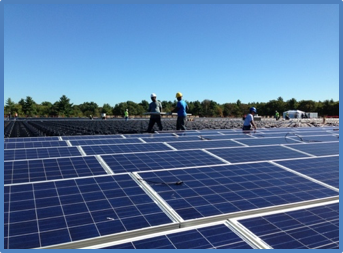 Solar installations have no moving parts and require little maintenance. Unlike major mechanical systems, there is no need to lubricate gears, change fan belts, or clean fuel tanks. Does this mean that solar does not require any maintenance? No, it is critical that your solar installation receive ongoing attention on a regular basis.
Solar installations have no moving parts and require little maintenance. Unlike major mechanical systems, there is no need to lubricate gears, change fan belts, or clean fuel tanks. Does this mean that solar does not require any maintenance? No, it is critical that your solar installation receive ongoing attention on a regular basis.
There are a few main reasons to have an experienced solar company maintain your existing solar installation:
- Safety
- Preventative Maintenance
- Output
Safety
Solar installations are generally safe and have redundant safety systems in place. However, a regular inspection would identify any failing conditions. These failures could include blown fuses, overheated terminations, worn wires, and separated connections. Electrical equipment that is compromised can cause arcing, heat, or fire and should be corrected immediately.
Preventative Maintenance
In many cases, catastrophic system failures will present warning signs in advance. A regular, proactive solar inspection can identify potentially dangerous conditions and prevent future failures. Experienced solar technicians would look for indications such as loose or dangling connections, solar panel “hot spots,” moisture infiltration, and stressed wires. By correcting these warning signs proactively, you may be able to prevent safety hazards in the future.
Output
A regular inspection could also ensure that your solar installation is maximizing output. Most solar owners believe that their installation is operating at its peak, but it is hard to know for certain. With many monitoring applications, the solar output is captured at a high level, and minor system under-performance is lost. Solar installations may suffer from minor losses caused by panel-level issues such as bypass diodes, “snail trails,” degradation, or soiling. In addition, components such as inverters or combiner boxes may have performance issues that are not obvious when monitoring at a system-wide level. The cost of this solar review is easily recouped by correcting any under-performance issues.

Solar Checklist
A regular solar inspection should include a thorough review of all system components and should be performed at least on an annual basis. Some key items on your inspection checklist should include:
- Visual Inspection
- Check racking, ballast, wires, and connectors
- Electrical Inspection
- Check electrical readings at all termination points
- Infrared (IR) Scan
- Check for signs of heat on modules, terminations, and electrical gear
- Torque Check
- Check hardware for loose or failing fasteners
- IV Curve Trace
- Check module strings for actual vs. expected performance
- Dirt/Debris
- Inspect for excessive dirt and debris and replace or clean air filters
- Corrective Plan
- Summarize findings to establish a baseline and provide a recommended action plan
Solar is generally a low-maintenance investment, but a proper maintenance plan is essential to safe operations. In addition, regular inspections can ensure that your solar installation maximizes its electricity yield. This will increase not only the savings to your bottom line, but also help increase the carbon savings for our planet.